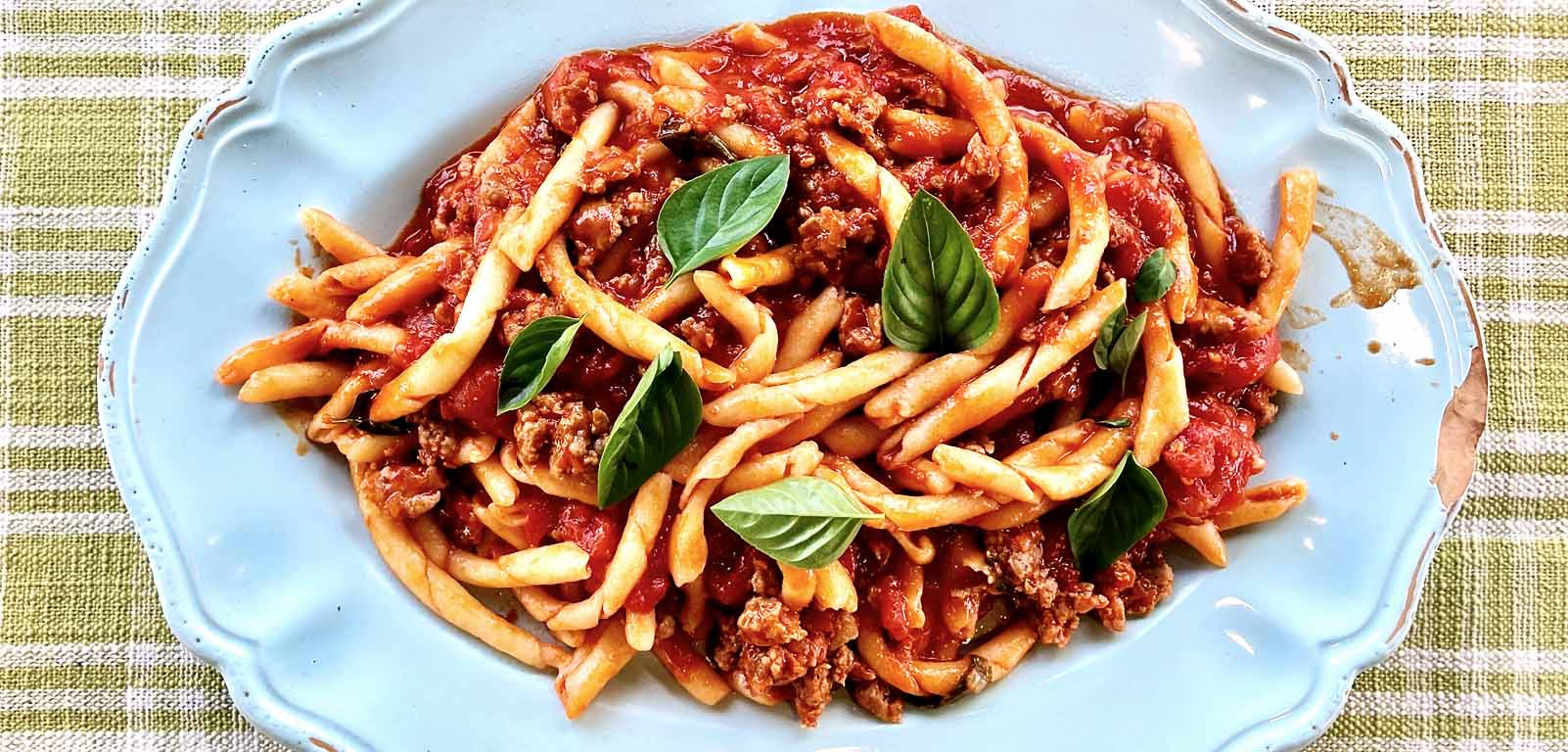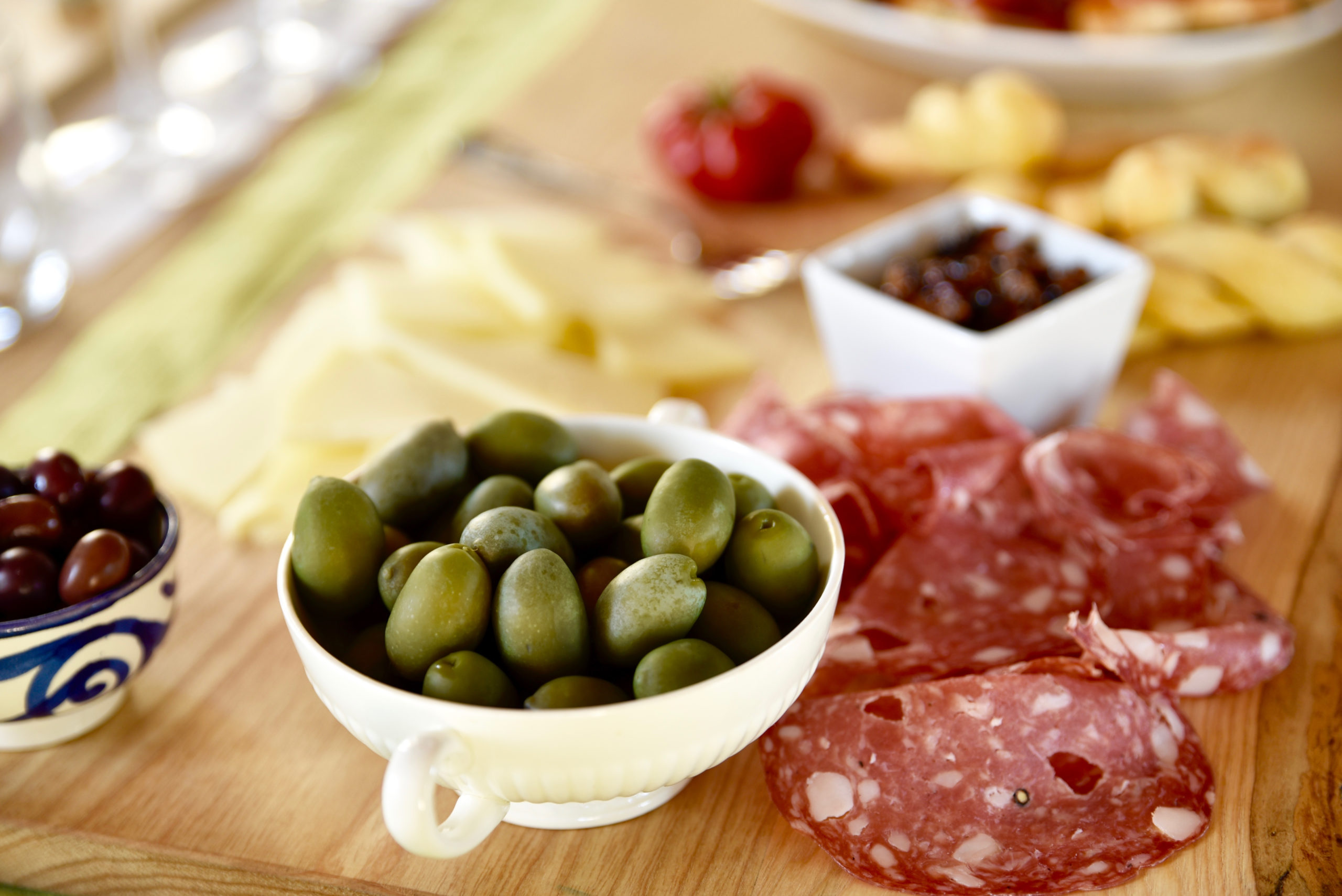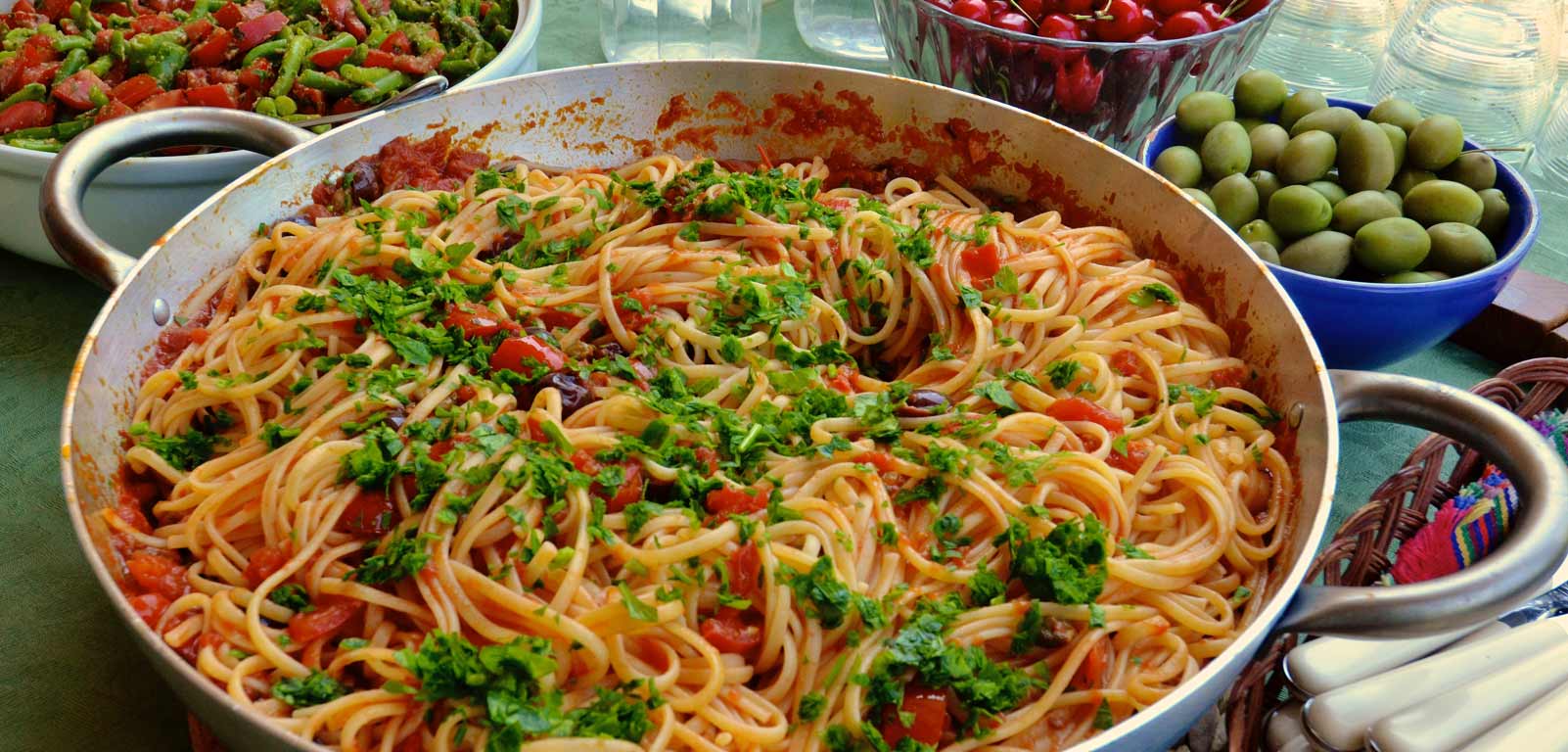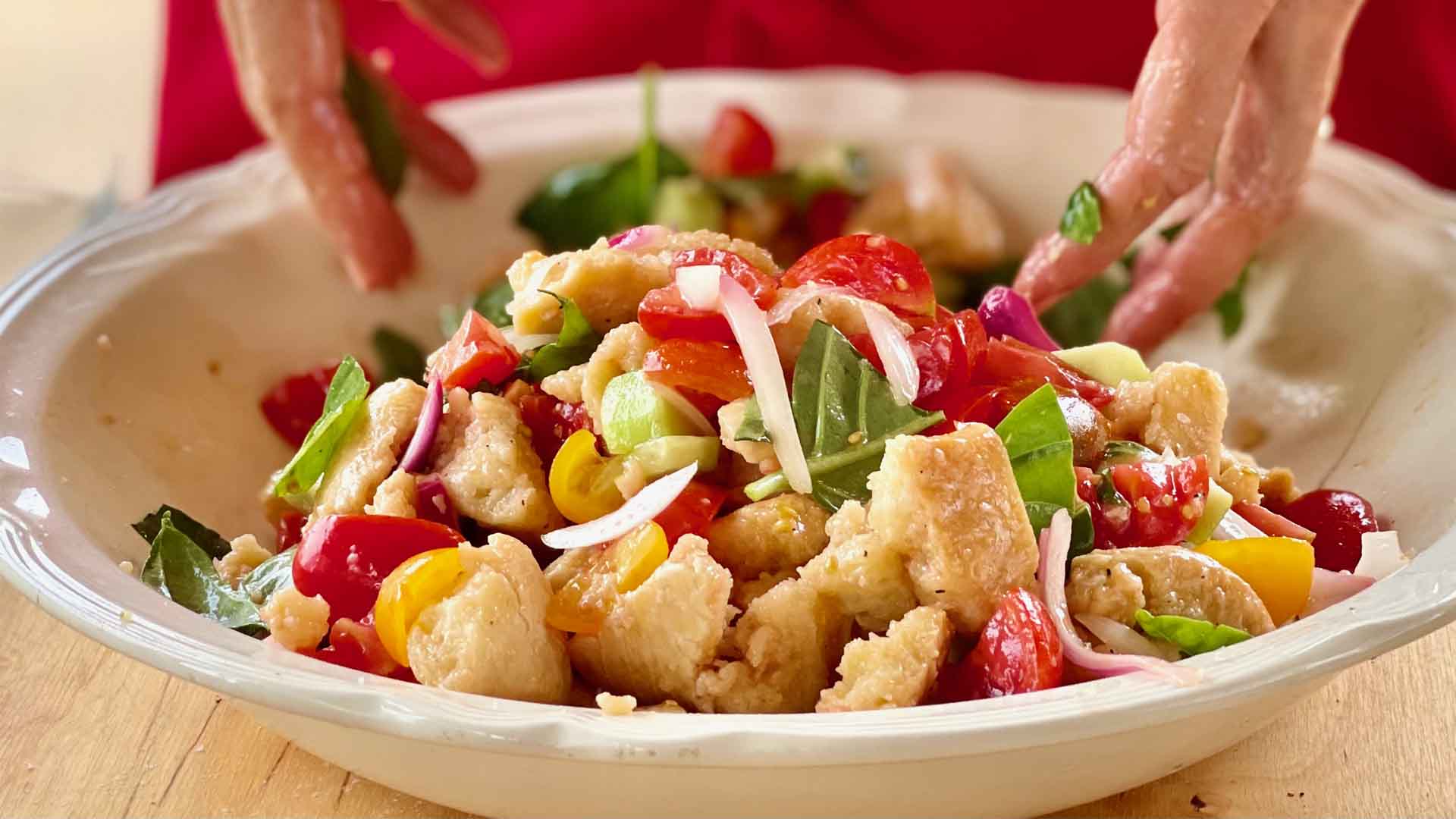Although it’s impossible to make a list of the most popular foods in Italy, when you think of Italian cuisine you probably think of pasta, pizza and tomato. Maybe even extra virgin olive oil, which is at the base of many dishes and the Mediterranean diet. And while these are typical things you can find all over Italy (and the world), it’s just the crust of a cuisine rich in history and regional diversity.
In this post:
- What to know about Italian food?
- Why are ingredients so important to Italians?
- What are Italy’s famous ingredients?
- What are Italy’s famous dishes?
- Why is Italy so famous for food?
- What are 5 interesting facts about Italy?
- What are the differences in regional cuisine in Italy?

What to know about Italian food and Italian cuisine?
The first and most important fact to know about Italian food is that it’s delicious. There’s a reason why so many people enjoy this cuisine and why it can be found world wide. But why?
Italian food is accessible. This is one of the most understated reasons people love Italian food. Italians have shown that really great tasting food does not have to be overly expensive or complicated.*
Italian cuisine is steeped in a tradition of home cooking using and highlighting simple ingredients like extra virgin olive oil and the humble tomato. But Italy also produces specialty ingredients with techniques and traditions dating back centuries. Things like cheesemaking, meat curing, winemaking, and balsamic vinegar go back generations and generations. But whether you use simple or traditional ingredients, the truth remains that for many of Italy’s most famous dishes like pasta and pizza, require a few ingredients and simple preparations.
Are there modern and fancy Italian restaurants and recipes, yes! But the majority of Italian cooking is based on simplicity and home based cooking, “just like Nonna used to make it.”
But it’s not just the ingredients that make Italian food accessible. It’s also the cost. Because dishes like pasta and pizza can be prepared with simple ingredients (flour, tomatoes, cheese), the overall cost of these dishes are affordable for everyone. Some of Italy’s best street food found in cities like Rome and Florence are pasta stands serving up delicious variations for around 5 Euros.
Italian foods have a very rich history. Think of a favorite recipe that your family enjoys. Take a second to imagine where that recipe comes from and how long your family has been making it.
For Italian families, some of the recipes and traditions have been passed down for many generations. In some cases, the recipes haven’t been changed at all to preserve a rich tradition.
While many food fads come and go, certain dishes live forever because of how good they are, but often, because of how easy it is to teach and pass on. Italian cuisine offers both.
Italian food is both recognizable and different by region. You can find risotto throughout Italy but different regions will have their own take on this classic Italian dish.
In the north, cities like Milan will cook and finish their risotto dishes with butter.
In the south of Italy they finish their risotto with a final blessing with extra virgin olive oil.
Regional differences are more obvious like that of people who live amongst the coast vs. those that are inland or in the mountains. Regional coastal dishes will heavily feature seafood and other ingredients that aren’t as easy to get. In the inland areas, you may see more meat centric dishes or offerings.
One important distinction between the north and the south is the use of spice.
The further south you travel in Italy, the more likely you are to encounter spicy dishes. But one, VERY important regional difference is the availability and specialization of certain kinds of products (more on the importance of ingredients below).
Because of Italy and the European government, Italian ingredients are labeled in such a way that it’s clear to consumers of its origin. In Tuscany where there are endless olive groves, Extra Virgin Olive Oil is an important part of the region’s dishes. But it goes even deeper!!!
Cook online with me! Try my next Flour Gnocchi Cooking Class – it’s free!
Why are ingredients so important to Italians?
Italian food starts with the protection of some of their famous and important ingredients. Because of Italy’s rich historical preservation of their food culture, many ingredients are protected and come from a specific region.
Italy’s rich food traditions are also preserved and protected by the EU by giving specific labels to these foods that indicate their origins and the method of production. You can often find labels such as IGP or DOP or IGT, to protect the producers against any imitation and to certify the origin of the food for the consumers.
Take the well known and loved ingredient, Parmigiano Reggiano. In the US, you can go to a local store and find parmesan cheese. But they can’t call it Parmigiano Reggiano because this is a protected and certified ingredient. It can only be called Parmigiano Reggiano if it comes from certain regions/cities in Italy. There are over 200 protected ingredients. He are a few recognizable ones:
- Parmigiano reggiano
- Pecorino Toscano
- Prosciutto di Modena
- Aceto Balsamico di Modena (Balsamic Vinegar of Modena)
- Grana Padano
- Mozzarella di Bufala

Many of your favorite oils, vinegar, meats, and cheese that come directly from local producers in Italy are most likely labeled with a specific location and identification. Why does this matter? Control and protection. It makes certain that the quality and taste of an ingredient meets certain testing.
There’s also an interesting initiative started by La Cucina Italiana, a famous Italian culinary magazine since 1929, which in 2020 stepped up to have Italian food added to the UNESCO Heritage list. The aime of the initiative is the recognition of the cultural and human value of food in Italian life, something that defines our national identity.
Learn my easy flour gnocchi recipe in my upcoming online Cooking Class – it’s free!
What are Italy’s famous ingredients?
When we think of famous Italian ingredients we have to start Italian Olive Oil, but specifically Extra Virgin Olive Oil (EVOO). In the US alone, these imports from Italy are worth more than 1 billion annually.
EVOO is grown throughout Italy, but specifically in the central-southern half of the country. So many of Italy’s famous dishes incorporate EVOO that it’s no wonder this essential ingredient can be found worldwide.
Fun fact about Italian food exports — though Extra Virgin Olive Oil is a famous export, it’s nowhere as near as large as Italy’s exports of wine. Wine exports to the US alone was worth 2.1 billion in 2020. [source]
The next biggest and most famous ingredient globally is dry pasta. Easy to make, preserve, and ship, it’s a perfect export for Italy. Though many countries produce their own pasta, exports from Italy are still highly desirable and marketed.
Another famous Italian ingredient is aged cheese such as Parmigianno Reggiano and Pecorino.
Because these ingredients are also protected, there is a sense of exclusivity and speciality. Because of the value and size of this ingredient, they are exported in large quantities and then broken into smaller pieces which are then sold in mass.
On a similar level to aged cheese, Italy is also famous for their balsamic vinegars and cured meats.
Some balsamic vinegars can come from mothers and productions that are centuries old. Cured meats like prosciutto are also famous, but not heavily exported. That being said, going to a butcher or market in Italy is fun to see all of the variety of cured meats you can find.
These are just a few of Italy’s famous ingredients. You’re likely to think of more, especially when you think of famous Italian dishes. For example, risotto is world famous and thus, you can probably find specialty Italian rice like Arborio, Carnaroli, and Roma, just to name a few varieties.

What are Italy’s famous dishes?
Italy’s most popular and famous dishes worldwide have to be Pizza and Pasta.
In almost every part of the world you can find these two dishes, or at least variations of them. But it’s important to note that both Pizza and Pasta represent larger categories of dishes that vary from region to region in Italy.
For example, pizza in the southern part of Italy will be known for a different style of crust and sauce than its northern counterparts. The same can be said for pasta. You might have similarities but there can also be a lot of difference in ingredients and techniques from region to region.
Why are pizza and pasta Italy’s most famous dishes? The first thing to note is that they both are simple and tasty that can satisfy a wide audience.
Because the ingredients for these dishes are humble and inexpensive, many people can experience these tasty dishes. Both are based on dough (flour & water) and sauce (usually made with something simple like tomatoes).
From this base, many different variations can be made, going from the simplest and inexpensive ingredients (like tomatoes and mozzarella) to complicated and really expensive ingredients (like rare truffles). But it’s the combination of taste and accessibility that has made pizza and pasta Italy’s most famous dishes world wide.
Famous variations of Italian pizza can include Marinara (tomato sauce), Margherita (tomato sauce and mozzarella with basil), Frutti di Mare (seafood), Prosciutto, and Truffle.
BBQ and Hawaiian pizzas are not traditionally Italian and don’t ask for pineapple on pizza in Italy!
There are many famous varieties of Italian pastas that vary based on the shape of the pasta noodle and sauce used in combination to complete the dish.
Here is a quick list (but not limited to) or some of Italy’s most famous pasta shapes: Tagliatelle, pappardelle, fettuccine, gnocchi, Fusilli, Lasagna, Spaghetti, Ravioli, etc…
Here is a quick list (with so many more that could be listed) of other famous Italian dishes:
Risotto: a hot rice dish with many variations based on regional and seasonal ingredients. Risotto has a creamy texture, obtained by the rice starch without the addition of any cream. Due to the special technique of making a risotto, the rice holds its shape with a slight chew, while the dish is creamy and tasty. A risotto is also the base for another famous Italian dish, Arancini, which is actually a risotto that is turned into breaded stuffed balls that are fried and served as an antipasto.
Tiramisu: the most famous Italian dessert made from coffee, lady fingers, and Marscapone cheese. So many variations of this famous dessert (cakes, fruit based, etc…).
Gelato: another famous Italian dessert with lots of different varieties and flavors. Don’t mistake US based gelato as the same as Italian. There’s a difference in the process of how Gelato is made in Italy that makes it more creamy and delicious.
Gnocchi: is technically a shape so it’s both a dish that can be categorized as a pasta and on its own. While many people around the world are familiar with potato based gnocchi pasta, Gnocchi can be made with a wide range of ingredients including spinach and ricotta and semolina flour.
Cook online with me! Try my next Flour Gnocchi Cooking Class – it’s free!
Osso Bucco: pork shanks slowly braised and served with a saute of vegetables over a bed of saffron risotto.
Baked Goods: Focaccia, Chibatta, and Schiaccia are just a few of the famous Italian bread styles. Perfect to eat with toppings like cured meat and cheese or by itself.

Why is Italy so famous for food?
Italy is famous for its cuisine because it’s simple and delicious. It starts with world class ingredients that are lovingly cared for with preparation techniques that have been passed down for many generations.
My mantra in the kitchen is “the simple use of the best ingredients’ ‘ and this a great reflection of what makes Italian food so good and famous.
Some of our most famous dishes do not have a lot of ingredients or complicated steps. Take for instance a beloved Italian dish that I share with guests that visit me, Spaghetti alla Puttanesca.
The spaghetti noodles are made from durum wheat with no extra preservatives or flavoring. The sauce for this pasta dish is made from tomatoes, garlic, capers, olive di Gaeta, parsley, and extra virgin olive oil. That’s it. But it’s the quality of these ingredients combined with the slow simmering that brings it together. It’s delicious.
Many of the beloved and famous dishes of Italy are accessible by people all over the world because they use ingredients that many people have access to. Flour. Eggs. Tomatoes. Extra Virgin Olive Oil. Some kinds of cheese. Meat. Rice. Etc…
So many people around the world can cook Italian cuisine which is why so many people are familiar with it.
But often people wonder why Italian food tastes better in Italy. The secret is no secret. It’s the ingredients.
Many of which as mentioned before are protected by Italy and the European Union and more specifically by certain regional areas. For example, if you want to make a pasta and use parmesan cheese on the dish, just know it’s not the same thing using Parmigiano Reggiano, a type of parmesan that meets certain standards and qualifications to be certified as such.
This is why many people visit Italy (and all of its regions) to eat. Because of the ingredients. It’s also why Italy’s cuisine is so famous and why grocery stores around the world import ingredients directly from Italy.
What are 5 interesting facts about Italian Food
1. In Italy, the cuisine is focused on traditional recipes that feature fresh, local, and high-quality ingredients. A traditional full course meals typically consist of three or four dishes: antipasti platter (that may include bruschetta, cheese, cured meats or pickled vegetables); a first course (pasta, rice or soup); a second course (fish or met); a side dish (a salad or a vegetable dish) and a dessert.
This full course meal is usually served on special occasions, whereas on a regular basis we only eat one course plus a side dish of vegetables. Relying on recipes that call for only a few ingredients, a good homemade meal or also eating out in a restaurant, is not only delicious but should not be that expensive.
2. Italian cuisine is also known for its variety and regional tradition and is a reflection of the country’s diverse landscapes, climate and available ingredients.
3. Many recipes belong to the so-called cucina povera, the no-waste “poor cooking” from peasant’s tradition. When tossing food was not an option, the number one rule was, “use what you have in your pantry.” This style of cooking is characterized by using simple, pantry ingredients like beans, vegetables, grains, and olive oil. The result is simple and affordable dishes, easy to cook on a daily basis.
4. Although some recipes are quite similar throughout the country, many dishes will vary by region, depending on what ingredients are available in that area. In the North, dishes like polenta and risotto are popular, while pasta is more common in the south. The same dish can have different names and be prepared in different ways from region to region, depending on the ingredients available. For example, extra virgin olive oil is a staple in Southern Italy whereas Northern Italy tends to use butter more often.
5. Another important reason why Italian cuisine is so delicious is because it is based on fresh and seasonal vegetables, fruits and herbs. This is why dishes are so tasty: their ingredients are at their best and release the most flavorful taste.
Eating by season is not only important, more sustainable, and tastier, but sometimes it’s the only choice we have. It’s a way of life in Italy. That’s why when something is in season and available only for a few months, I try to cook it and eat it as much as I can, before another long wait!
Every season brings with it new ingredients and recipes, making Italian cuisine unique and special, as it is constantly evolving with the changing seasons.
By combining the regional and seasonal aspects, it becomes clear why some ingredients are so protected and rare that they can only be obtained in Italy, from specific producers, and only during certain periods of the year.
Think about the prized white truffle of Alba, considered to be the most expensive ingredient in the world! This rare mushroom is harvested from a certain type of tree and can cost upwards of $5000 per pound! It’s available only a limited time of the year and with its unique and intense aroma, as well as its flavorful and meaty texture, it is used as a finishing touch to dishes in fine dining restaurants. It’s not something you can use everyday on your risotto!
Sign up for my next FREE Cooking Class online >
What are the differences in regional cuisine in Italy?
To truly savor the best of Italian cuisine, one should sample dishes in their area of origin. If you travel through the Italian boot from North to South, you’ll find a colorful patchwork of recipes, food, ingredients: each region, sometimes each village has their own specialties.
The North regions feature dishes with high-fat components such as butter or lard, due to the proximity of the Alps and the Po valley, where cows find the perfect environment to grow and provide the precious milk to make cheese and butter. Some menu’s staples include truffles, polenta, risottos, cheese, potatoes, and stewed meat.
The Central region’s cuisine is mainly based on cured meats, fresh pastas like ravioli, fettuccine, steak and game sauces, pork, pickled vegetables, and cheeses like Pecorino Toscano, in addition to Umbrian mushrooms and truffles.
In the South of Italy, where the Mediterranean diet is born, the culinary tradition is mainly based on seafood, pizza, pasta, beans, mozzarella di bufala, and extra-virgin olive oil as seasoning and flavor carrier. However, it is also important to bear in mind that Italian meals may be slightly different from one family to the next, with recipes passed down with an individual touch. Of course there are infinite debates on which is the best one!
From the seafood-rich coastal areas to the mountainous regions of the north, there is something to please every palate. Each region has its own unique dishes and specialties, making Italian cuisine truly one of a kind.
Conclusion: Italian Food is Amazing – Maybe the Best in the World!
Whether you go out to an Italian restaurant in your local area, cook Italian at home, or better yet, visit Italy yourself – Italy’s cuisine is world famous and you’ll know you’ll have a great meal. Italy’s famous cuisine starts with its ingredients but also includes company and sociability: a table with food is the perfect place to share conversations, laughs and make new friends. The only way to truly appreciate that is to visit our beautiful country!


